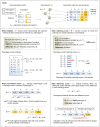Identifying tightly regulated and variably expressed networks by Differential Rank Conservation (DIRAC)
- PMID: 20523739
- PMCID: PMC2877722
- DOI: 10.1371/journal.pcbi.1000792
Identifying tightly regulated and variably expressed networks by Differential Rank Conservation (DIRAC)
Abstract
A powerful way to separate signal from noise in biology is to convert the molecular data from individual genes or proteins into an analysis of comparative biological network behaviors. One of the limitations of previous network analyses is that they do not take into account the combinatorial nature of gene interactions within the network. We report here a new technique, Differential Rank Conservation (DIRAC), which permits one to assess these combinatorial interactions to quantify various biological pathways or networks in a comparative sense, and to determine how they change in different individuals experiencing the same disease process. This approach is based on the relative expression values of participating genes-i.e., the ordering of expression within network profiles. DIRAC provides quantitative measures of how network rankings differ either among networks for a selected phenotype or among phenotypes for a selected network. We examined disease phenotypes including cancer subtypes and neurological disorders and identified networks that are tightly regulated, as defined by high conservation of transcript ordering. Interestingly, we observed a strong trend to looser network regulation in more malignant phenotypes and later stages of disease. At a sample level, DIRAC can detect a change in ranking between phenotypes for any selected network. Variably expressed networks represent statistically robust differences between disease states and serve as signatures for accurate molecular classification, validating the information about expression patterns captured by DIRAC. Importantly, DIRAC can be applied not only to transcriptomic data, but to any ordinal data type.
Conflict of interest statement
The authors have declared that no competing interests exist.
Figures








References
-
- Hood L, Heath JR, Phelps ME, Lin B. Systems biology and new technologies enable predictive and preventative medicine. Science. 2004;306:640–643. - PubMed
-
- Land H, Parada LF, Weinberg RA. Tumorigenic conversion of primary embryo fibroblasts requires at least two cooperating oncogenes. Nature. 1983;304:596–602. - PubMed
-
- Lowe SW, Cepero E, Evan G. Intrinsic tumour suppression. Nature. 2004;432:307–315. - PubMed
Publication types
MeSH terms
Grants and funding
LinkOut - more resources
Full Text Sources

